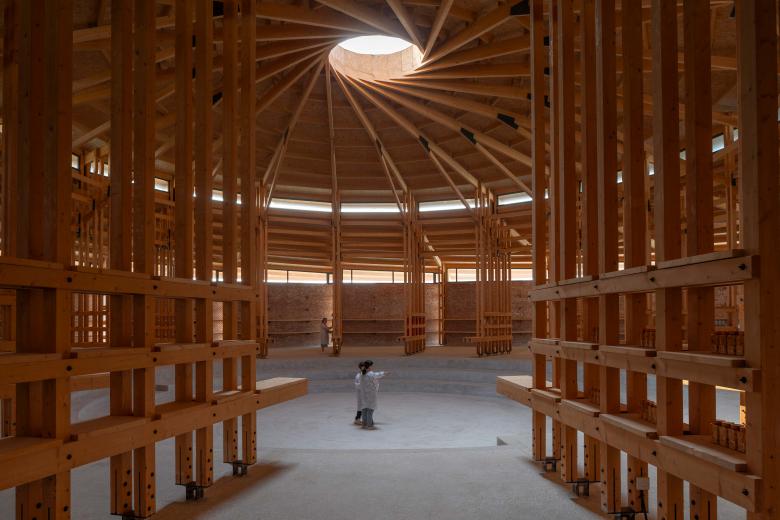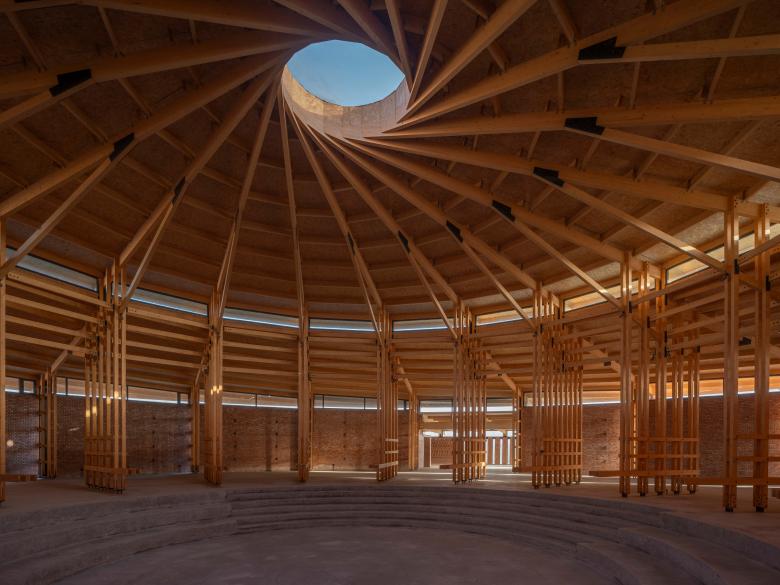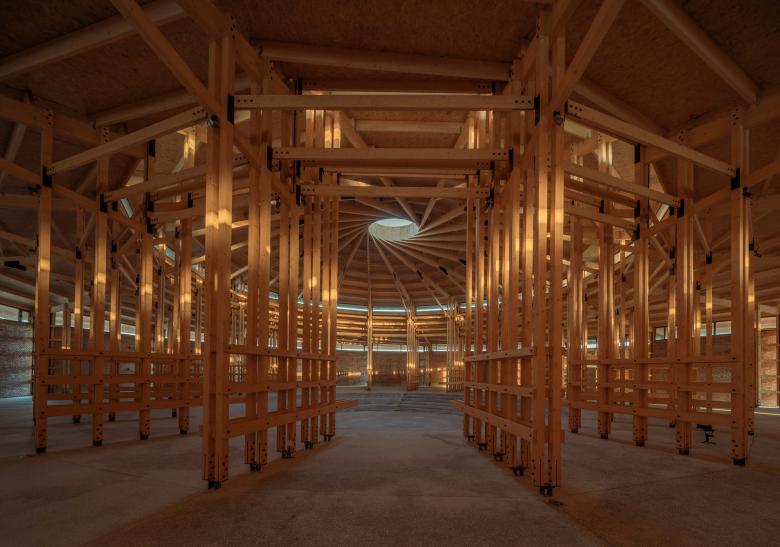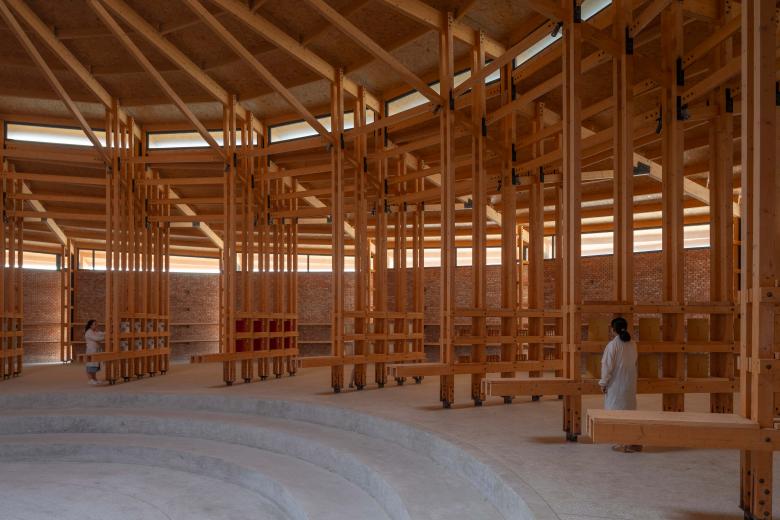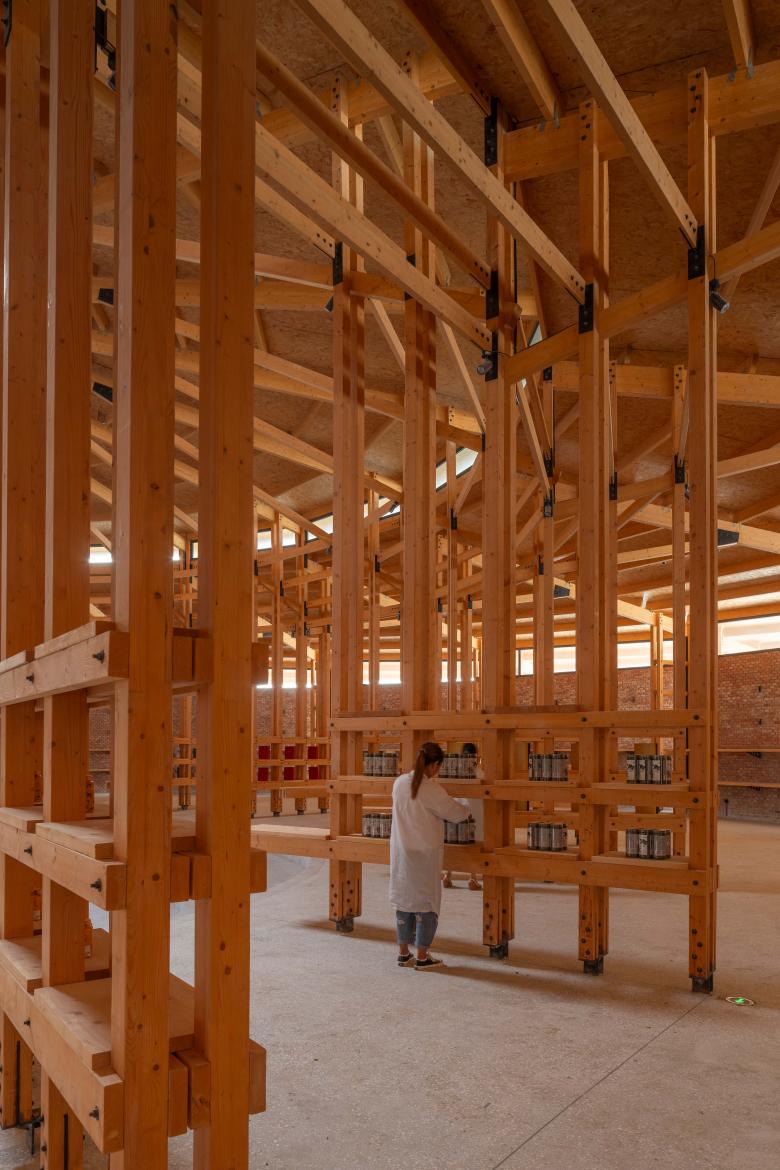Furniture as Structure, Prepared Rehmannia Root Crafts Exhibition Hall
Torna enrere a la llista de projectes- Localització
- Any
- 2021
Furniture as Structure, Prepared Rehmannia Root Crafts Exhibition Hall by LUO studio
Xiuwu County, situated in the western part of Henan Province within Jiaozuo City, was historically known as Huaiqing Prefecture. Blessed with unique soil and climate conditions, Xiuwu has been renowned as a production base of "Four traditional Chinese medicine herbs," with Rehmannia (also called "Di Huang" in Chinese) being one of them. The Chinese term "Shu Di Huang" specifically denotes the prepared or cooked Rehmannia root. Due to its significant medicinal and economic value, Shu Di Huang and its related industries in the county have garnered widespread attention.
01 Conceptual Shift from “Factory” to “Exhibition Hall”
The Ice Chrysanthemum Plantation in Houyanmen Village exemplifies the thriving medicinal herb planting industry supported by the government of Xiueu County. Specially approved funds from the provincial government target various aspects of the medicinal herb industry in Houyanmen Village, such as a processing workshop, a dry field, and a crafts exhibition hall of Rehmannia root products (i.e. Shu Di Huang). The processing workshop, which employed a portal frame structure, completed construction along with the drying field in 2020. The crafts exhibition hall, also adopting a portal frame structure system, started foundation pit excavation in 2020 and finished construction a year later. LUO studio was commissioned to work on its design in early 2021.
Houyanmen Village has been strategically prioritizing rural industrial revitalization, with plantation construction playing a pivotal role in the village’s overall development. A prevailing notion across the town, the village, and industrial parks is that buildings, even exhibition halls within industrial parks, are essentially workshops. Recognizing that traditional craftsmen and their techniques may not be well-suited for constructing large-span, open spaces, the buildings in the rural industrial parks often adopt a plant-like form due to their maturity in construction systems. This is a common practice in rural industrial park construction.
The rural industry, centered around planting, has transcended its conventional role limited to production spurred by informatization and all-around rural development. It now encompasses industrial tourism, nature education, e-commerce livestreaming, health and wellness, and more. The integration of primary, secondary, and tertiary industries is imperative for the industrial revitalization of rural areas. Therefore, employing a factory-style building with a traditional portal frame structure is not appropriate for a versatile exhibition hall in a rural industrial park. LUO studio actively communicated with and persuaded all stakeholders to discard conventional notions and embrace a new paradigm in the design and construction of the Prepared Rehmannia Root Crafts Exhibition Hall. While meeting the requirements of a large-span and open space, the new approach also embodies the attributes of the exhibition hall, local characteristics, and ecological considerations.
02 "Sunlight" as the Shared Core of Craftsmanship and Space
Through conducting on-site research on the processing techniques of Rehmannia roots, the design team discovered that the tradition of cooking Rehmannia roots can be traced back to ancient Chinese physician Sun Simiao's "nine steaming and nine sun-drying" methodology, which involved continuous cooking and drying processes linked to "sunlight." This unique traditional pharmaceutical process is a pivotal concept in shaping the Exhibition Hall’s space, which emphasizes an enriched light environment. Light becomes the central theme of the building, generating dynamic changes both inside and outside. This is the fundamental starting point for the design.
Viewed from the exterior, the play of light and shadow on a circular building body proves more nuanced, uniform, and continuous compared to a square structure. The circular form better showcases the changing light and shadow over time. Therefore, the design team decided to adopt a nearly round architectural form that features a regular polygon on the plane, to avoid arcs for precision and efficiency in construction while creating a curvy effect through straight lines.
Deviating from the common approach of carving out window holes in the building walls for daylighting, the design emphasized unconventional means for introducing natural light, such as through ceilings, eaves, and gaps in between walls.
03 Circular Plane
The centrally symmetrical circular plane is well-suited for the exhibition space. The visiting circulation is a key consideration for the internal space organization of the exhibition hall. It is essential to ensure a logically arranged circulation route, to avoid overlaps or detours. The project adopts a nearly circular plane, forming an inscribed circle with a diameter of 37 meters. The periphery of the inscribed circle becomes the circulation route for visitors. Such a layout strategy can effectively streamline subsequent work in exhibition arrangement and thus reduce cost, which is essential in rural construction.
Opting for a 37m-diameter central column frame within the structural framework is an economical solution. This design introduces dynamic variations in both space and scale, creating distinct "ring" spaces. The outer ring integrates the enclosure walls with wooden structures, creating a backdrop for placing display boards. The middle ring serves as a shelf area for displaying various Rehmannia root products. It incorporates densely organized structural units of the column frame, ensuring a stable structure and maximizing storage capacity. The inner ring, more expansive than the middle ring, is designed with a circular and stepped sunken seating area, offering a venue for health & wellness sessions and activities. The central skylight on the top brings in daylight while accentuating a sense of centrality.
04 Furniture - Structure- Space
The sustainable concept inherent in traditional wooden construction is noteworthy, which aligns with “Reduce” in the 3R principle and is specifically embodied by the “furniture as structure” methodology. An illustrative example is the clay-shaping rooms of ancient kilns in Jingdezhen, still in use today. These constructions utilize Chuandou timber frames as the structural system, where the columns are carved out with mortises for inserting small wooden beams, above which divider panels are then placed. These panels serve as platforms for shaped clay in the drying process. This practice reflects local construction wisdom, resonating with the ethos of cherishing resources. It not only saves materials and space, but also integrates structure, furniture, and space into a whole.
Inspired by such traditional construction wisdom, the project transforms traditional large-section columns into small-section column arrays, which are then stacked vertically and horizontally to secure secondary small wooden beams. Panels are subsequently laid on the small beams for holding items. These component groups, which are both structures and functional shelves, define a unique space.
Small column array groups were assembled side by side in the form of standardized modular units, offering two advantages in rural construction:
1) Large sections and heavier material rods typically demand large machinery for hoisting during construction. However, rural roads, characterized by narrow pathways, slopes, and depressions, pose challenges for the navigation of large equipment. Breaking down the structural system into small components facilitated manual movement, allowing villagers to participate in and organize the construction themselves.
2) The construction method involving standardized modular units enhanced processing and assembly efficiency, leading to significant savings in manpower and material resources. This approach is particularly well-suited for construction in rural settings.
05 Roof Truss in a Spirally and Circularly Overlapped Formation
Following the logical framework of the regular 18-sided polygon on the plane, the exhibition hall repositions one endpoint of each side towards the center of the inscribed circle, aligning it perpendicularly to the extension line of the structural columns. When viewed from the exterior, the adjoining side walls are staggered. The varied gaps between the 18 walls allow natural light to filter in and create a visually captivating interplay of light and shadow within the space. Viewed from the interior, a distinctive 2.5m-diameter hole emerges at the center of the dome, which is formed by the deliberate organization of columns and beams.
In the case of a circular dome, straightening rods from the arc points to the center of the circle could result in a densely structured central node. This could complicate the connection between the rods, requiring complicated central connecting components and high costs in processing and hoisting. Moreover, the 37m-diameter span of the entire building necessitates daylighting in the middle. To address these challenges, the design team conceived a structure in which the rods are mutually supportive and are connected in a spirally circular formation. This approach eliminates situations where two members share an endpoint, thereby avoiding the creation of hinged nodes. The wooden beams support each other in a spiral, distributing pressure, overlapping, and ultimately forming a continuous and complete stress system.
06 Brick, Timber and Genius Loci
Most of the houses in Houyanmen Village were constructed during the 1970s and the 1990s, characterized by red-brick masonry walls and triangular wooden frame roofs. Other houses include idle, abandoned buildings with gray brick walls and Tailiang-style timber frame structures, as well as brick-concrete houses built prior to 2000. Huanfeng Town, to which Houyanmen Village belongs, has had brick kilns since the Ming and Qing Dynasties. Some of those kilns are still producing red bricks, situated merely 2 to 3 kilometers away from Houyanmen Village. Red bricks produced in the town, due to their cost-effectiveness, remain the primary materials for the villagers building their homes. In this project, local red bricks are applied to the enclosure walls and internal partition walls, constructed by local craftsmen using traditional masonry techniques.
Traditional houses in the village typically feature brick walls on the lower section and wooden frames on the upper part. The project adopts a similar material scheme. To accommodate the need for a spacious exhibition area, the wooden frame not only forms the upper roof but also functions as the frame-column support for the lower part. To ensure durability and prevent issues such as cracking and deformation of logs, glulam, and wooden poles were chosen, and the timber rods were securely fastened with bolts through metal connecting components. The combination of the local red-brick masonry wall techniques with the engineered wood frame structure enhances both the structural integrity and durability while aligning with the traditional built environment in the village. This approach ensures that the rural industry display building not only meets spatial quantity requirements but also delivers high-quality spatial aesthetics that echo the genius loci.
Project information
Project name: Prepared Rehmannia Root Crafts Exhibition Hall
Client: People’s Government of Huanfeng Town, Xiuwu County
Design firm: LUO studio
Website: www.luostudio.cn
Design team: Luo Yujie, Wang Beilei, Cao Yutao, Huang Shangwan, Zhang Chen
Construction team: Henan Shancheng Construction Engineering Co., Ltd
Location: Houyanmen Village, Huanfeng Town, Xiuwu County, Henan Province
Area: 1,463 sqm
Photography: Jin Weiqi















